torque MITSUBISHI 380 2005 Workshop Manual
[x] Cancel search | Manufacturer: MITSUBISHI, Model Year: 2005, Model line: 380, Model: MITSUBISHI 380 2005Pages: 1500, PDF Size: 47.87 MB
Page 511 of 1500
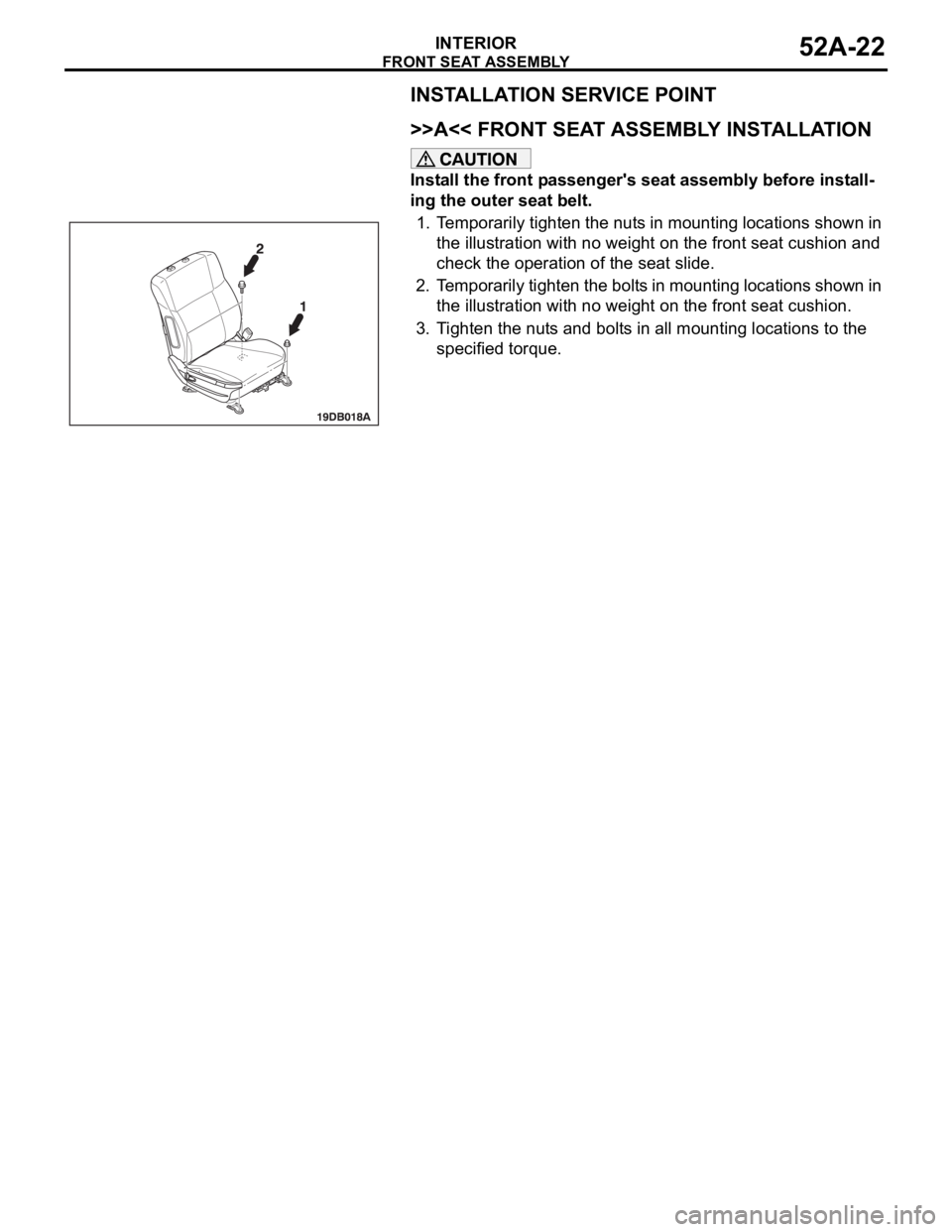
FRONT SEAT ASSEMBLY
INTERIOR52A-22
INSTALLATION SERVICE POINT
.
>>A<< FRONT SEAT ASSEMBLY INSTALLATION
Install the front passenger's seat assembly before install-
ing the outer seat belt.
1. Temporarily tighten the nuts in mounting locations shown in
the illustration with no weight on the front seat cushion and
check the operation of the seat slide.
2. Temporarily tighten the bolts in mounting locations shown in
the illustration with no weight on the front seat cushion.
3. Tighten the nuts and bolts in all mounting locations to the
specified torque.
Page 869 of 1500
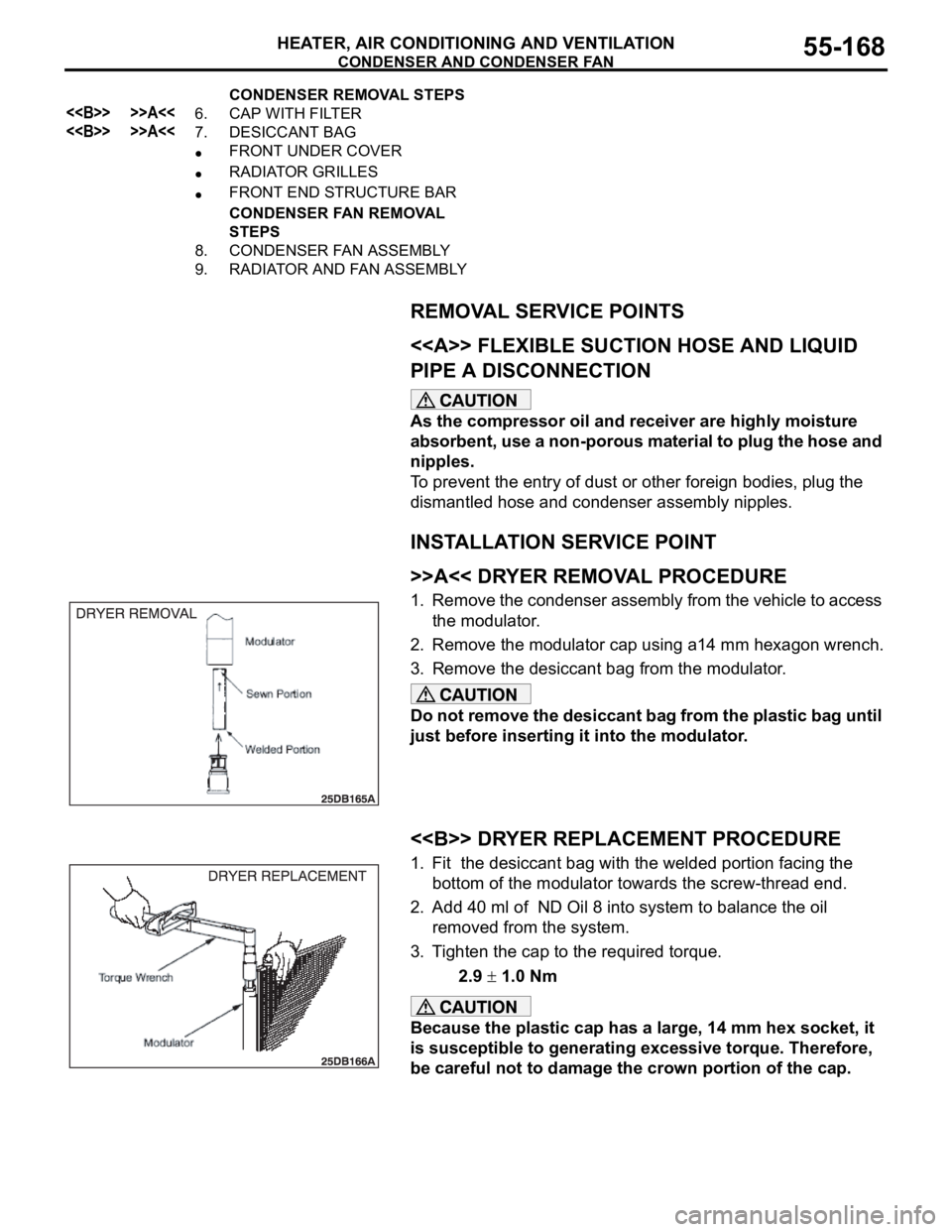
Page 872 of 1500
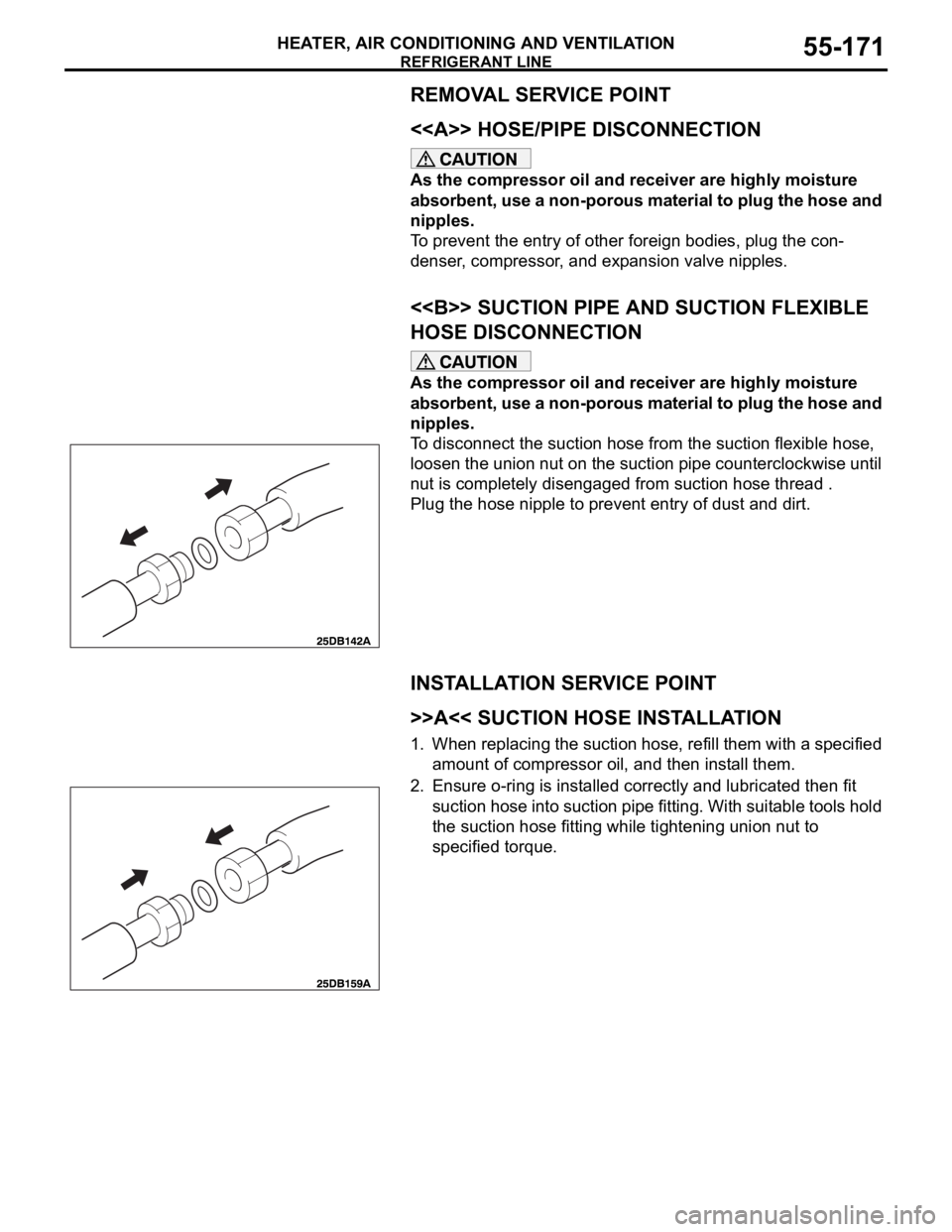
Page 875 of 1500
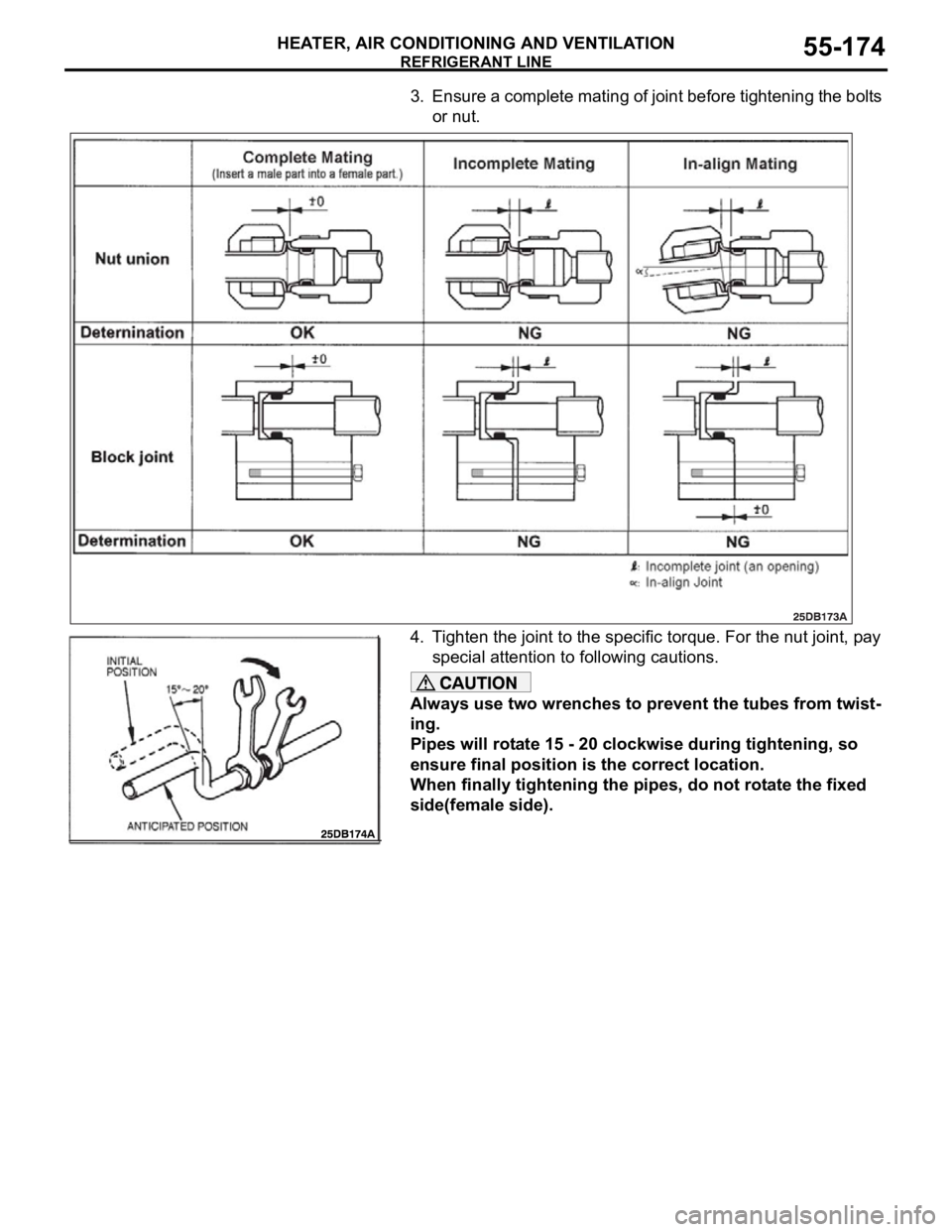
REFRIGERANT LINE
HEATER, AIR CONDITIONING AND VENTILATION55-174
3. Ensure a complete mating of joint before tightening the bolts
or nut.
4. Tighten the joint to the specific torque. For the nut joint, pay
special attention to following cautions.
Always use two wrenches to prevent the tubes from twist-
ing.
Pipes will rotate 15 - 20 clockwise during tightening, so
ensure final position is the correct location.
When finally tightening the pipes, do not rotate the fixed
side(female side).
Page 943 of 1500
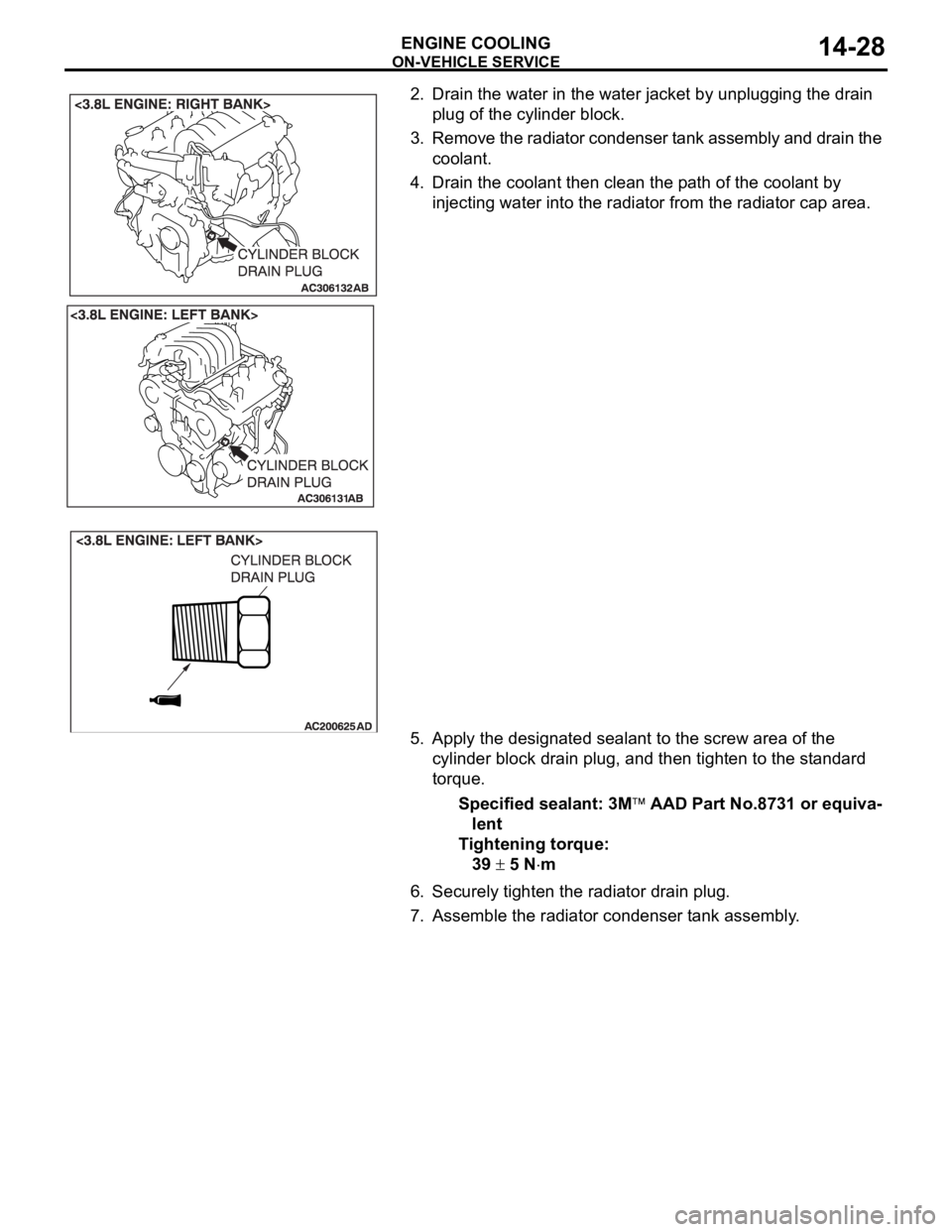
ON-VEHICLE SERVICE
ENGINE COOLING14-28
2. Drain the water in the water jacket by unplugging the drain
plug of the cylinder block.
3. Remove the radiator condenser tank assembly and drain the
coolant.
4. Drain the coolant then clean the path of the coolant by
injecting water into the radiator from the radiator cap area.
5. Apply the designated sealant to the screw area of the
cylinder block drain plug, and then tighten to the standard
torque.
Specified sealant: 3M
AAD Part No.8731 or equiva-
lent
Tightening torque:
39
5 Nm
6. Securely tighten the radiator drain plug.
7. Assemble the radiator condenser tank assembly.
Page 956 of 1500
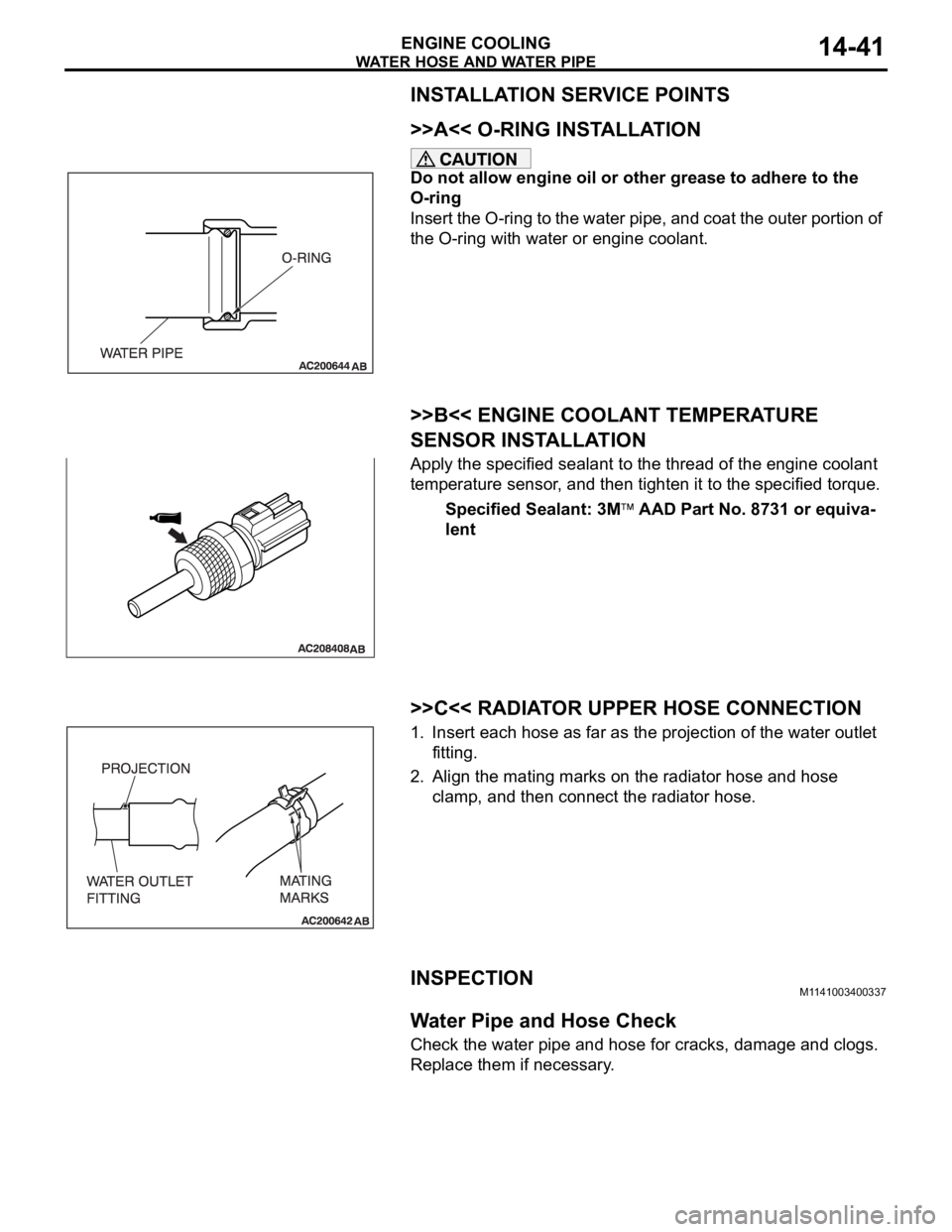
WATER HOSE AND WATER PIPE
ENGINE COOLING14-41
INSTALLATION SERVICE POINTS
.
>>A<< O-RING INSTALLATION
Do not allow engine oil or other grease to adhere to the
O-ring
Insert the O-ring to the water pipe, and coat the outer portion of
the O-ring with water or engine coolant.
.
>>B<< ENGINE COOLANT TEMPERATURE
SENSOR INSTALLATION
Apply the specified sealant to the thread of the engine coolant
temperature sensor, and then tighten it to the specified torque.
Specified Sealant: 3M
AAD Part No. 8731 or equiva-
lent
.
>>C<< RADIATOR UPPER HOSE CONNECTION
1. Insert each hose as far as the projection of the water outlet
fitting.
2. Align the mating marks on the radiator hose and hose
clamp, and then connect the radiator hose.
INSPECTIONM1141003400337.
Water Pipe and Hose Check
Check the water pipe and hose for cracks, damage and clogs.
Replace them if necessary.
Page 967 of 1500
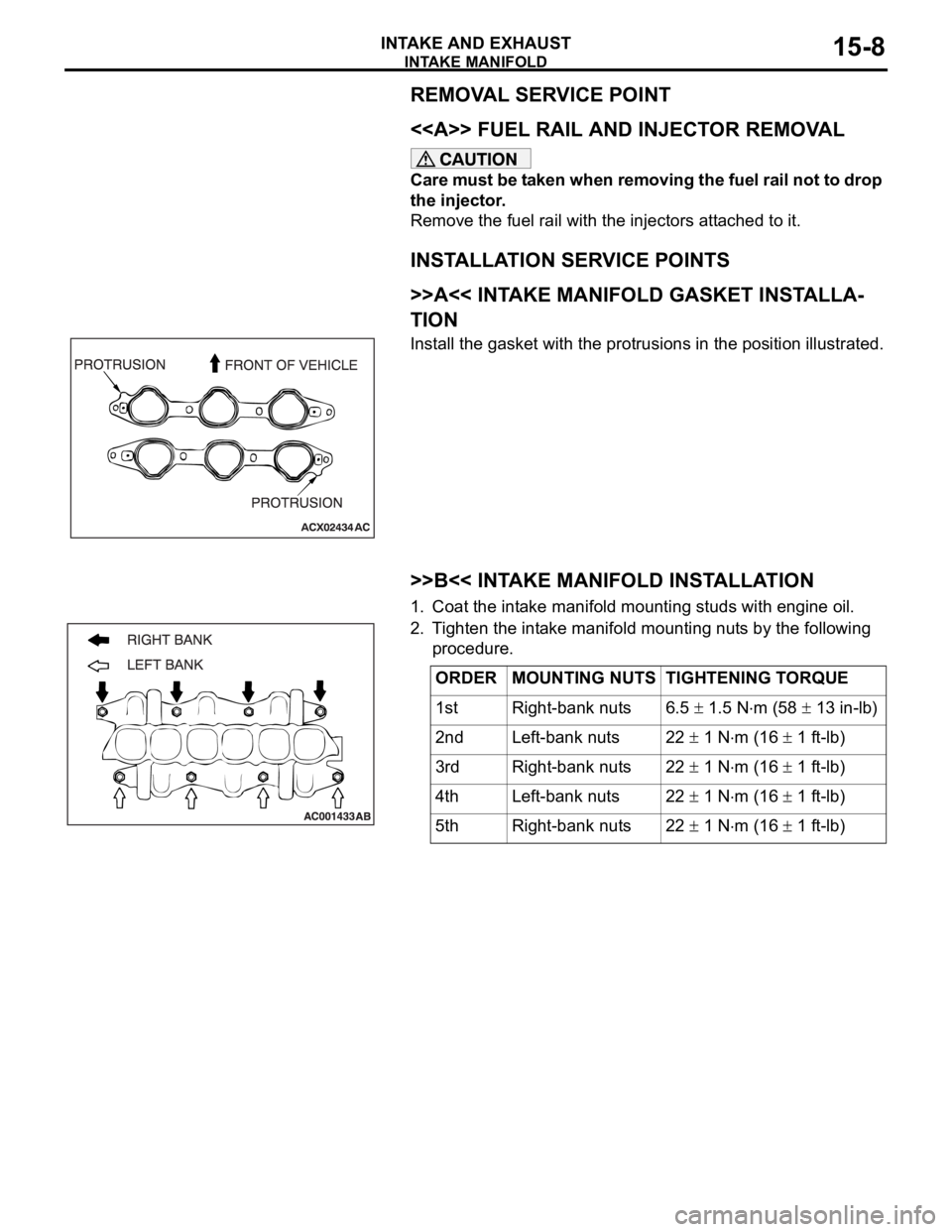
Page 1029 of 1500
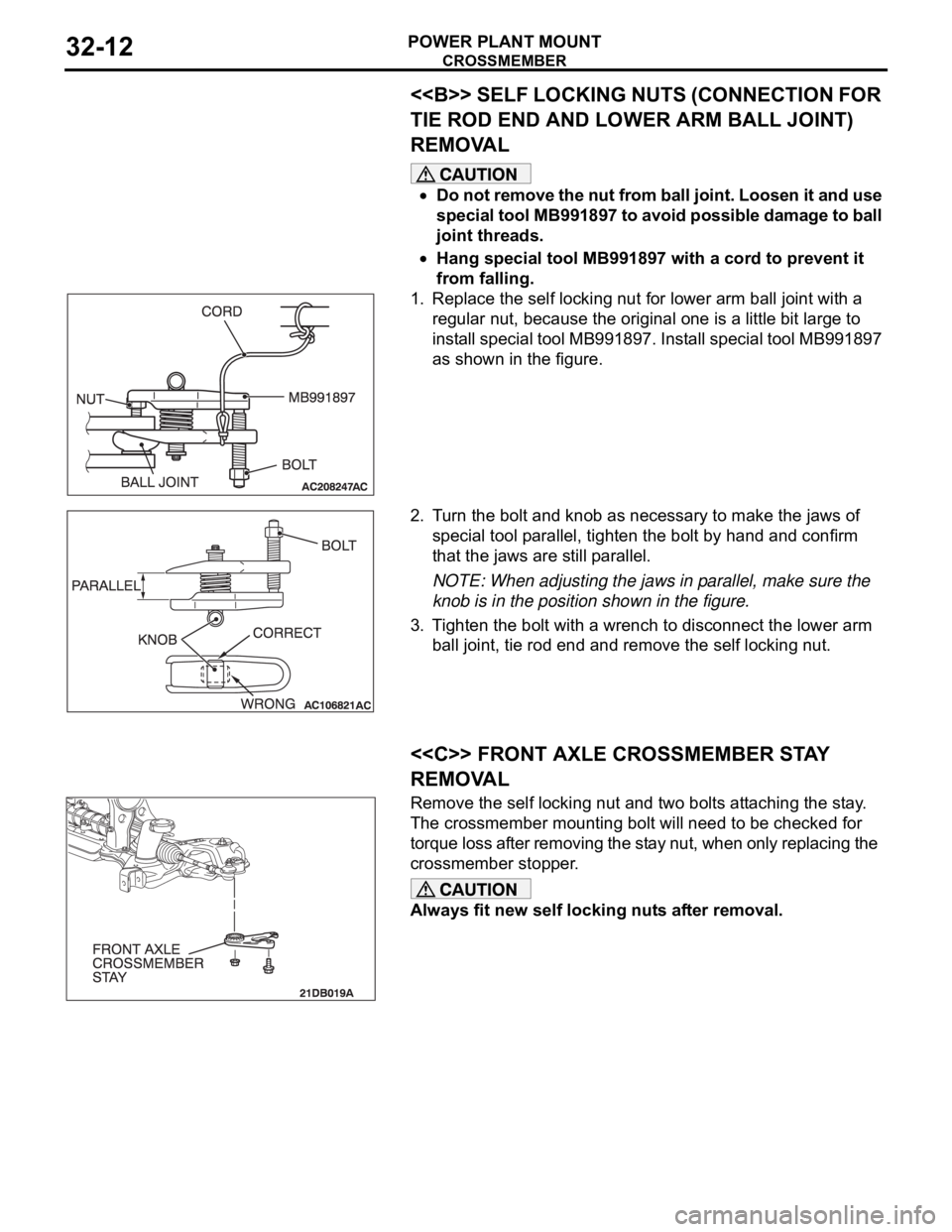
CROSSMEMBER
POWER PLANT MOUNT32-12
<> SELF LOCKING NUTS (CONNECTION FOR
TIE ROD END AND LOWER ARM BALL JOINT)
REMOVAL
Do not remove the nut from ball joint. Loosen it and use
special tool MB991897 to avoid possible damage to ball
joint threads.
Hang special tool MB991897 with a cord to prevent it
from falling.
1. Replace the self locking nut for lower arm ball joint with a
regular nut, because the original one is a little bit large to
install special tool MB991897. Install special tool MB991897
as shown in the figure.
2. Turn the bolt and knob as necessary to make the jaws of
special tool parallel, tighten the bolt by hand and confirm
that the jaws are still parallel.
NOTE: When adjusting the jaws in parallel, make sure the
knob is in the position shown in the figure.
3. Tighten the bolt with a wrench to disconnect the lower arm
ball joint, tie rod end and remove the self locking nut.
.
<
REMOVAL
Remove the self locking nut and two bolts attaching the stay.
The crossmember mounting bolt will need to be checked for
torque loss after removing the stay nut, when only replacing the
crossmember stopper.
Always fit new self locking nuts after removal.
.
Page 1097 of 1500
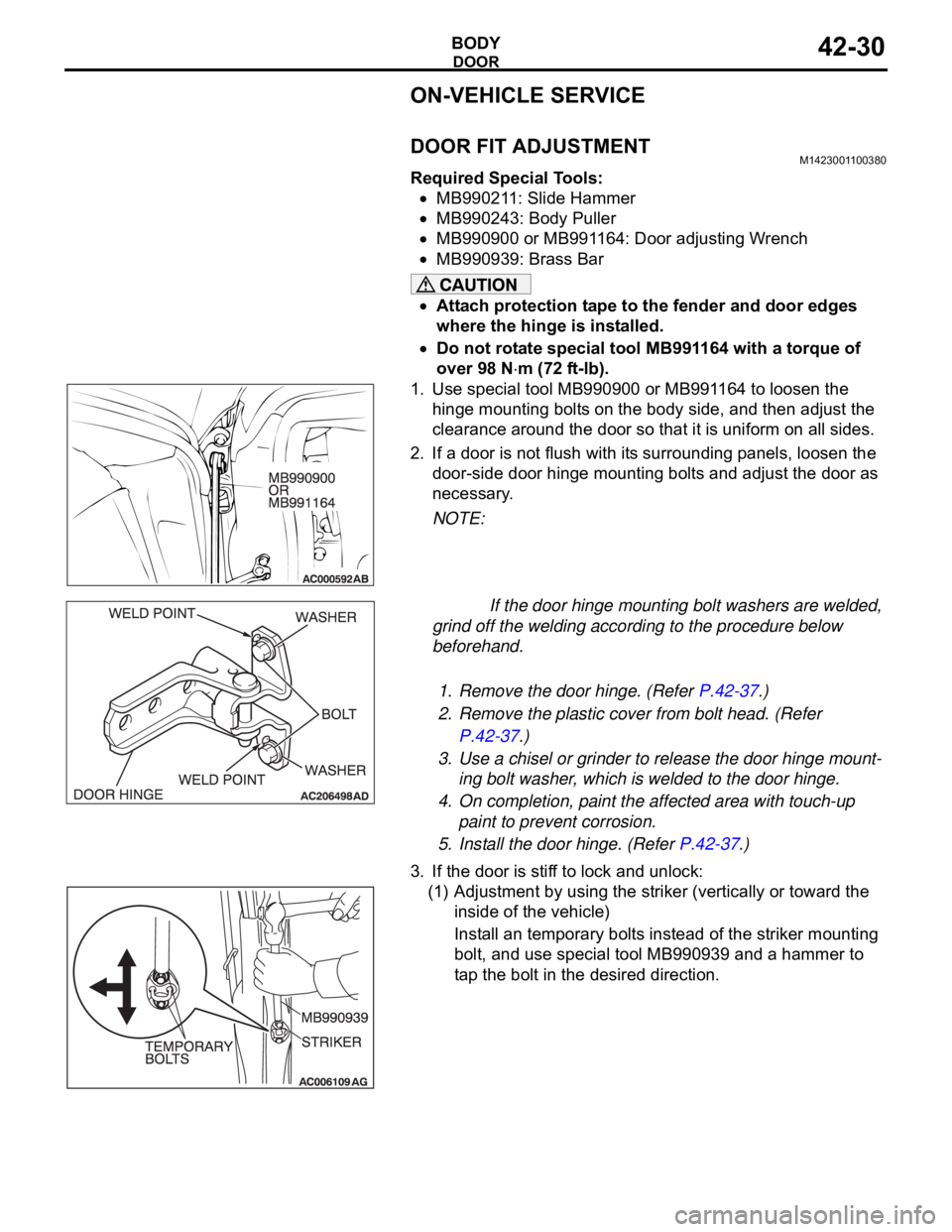
DOOR
BODY42-30
ON-VEHICLE SERVICE
DOOR FIT ADJUSTMENTM1423001100380
Required Special Tools:
MB990211: Slide Hammer
MB990243: Body Puller
MB990900 or MB991164: Door adjusting Wrench
MB990939: Brass Bar
Attach protection tape to the fender and door edges
where the hinge is installed.
Do not rotate special tool MB991164 with a torque of
over 98 N
m (72 ft-lb).
1. Use special tool MB990900 or MB991164 to loosen the
hinge mounting bolts on the body side, and then adjust the
clearance around the door so that it is uniform on all sides.
2. If a door is not flush with its surrounding panels, loosen the
door-side door hinge mounting bolts and adjust the door as
necessary.
NOTE:
If the door hinge mounting bolt washers are welded,
grind off the welding according to the procedure below
beforehand.
.
1. Remove the door hinge. (Refer P.42-37.)
2. Remove the plastic cover from bolt head. (Refer
P.42-37.)
3. Use a chisel or grinder to release the door hinge mount-
ing bolt washer, which is welded to the door hinge.
4. On completion, paint the affected area with touch-up
paint to prevent corrosion.
5. Install the door hinge. (Refer P.42-37.)
3. If the door is stiff to lock and unlock:
(1) Adjustment by using the striker (vertically or toward the
inside of the vehicle)
Install an temporary bolts instead of the striker mounting
bolt, and use special tool MB990939 and a hammer to
tap the bolt in the desired direction.
Page 1158 of 1500
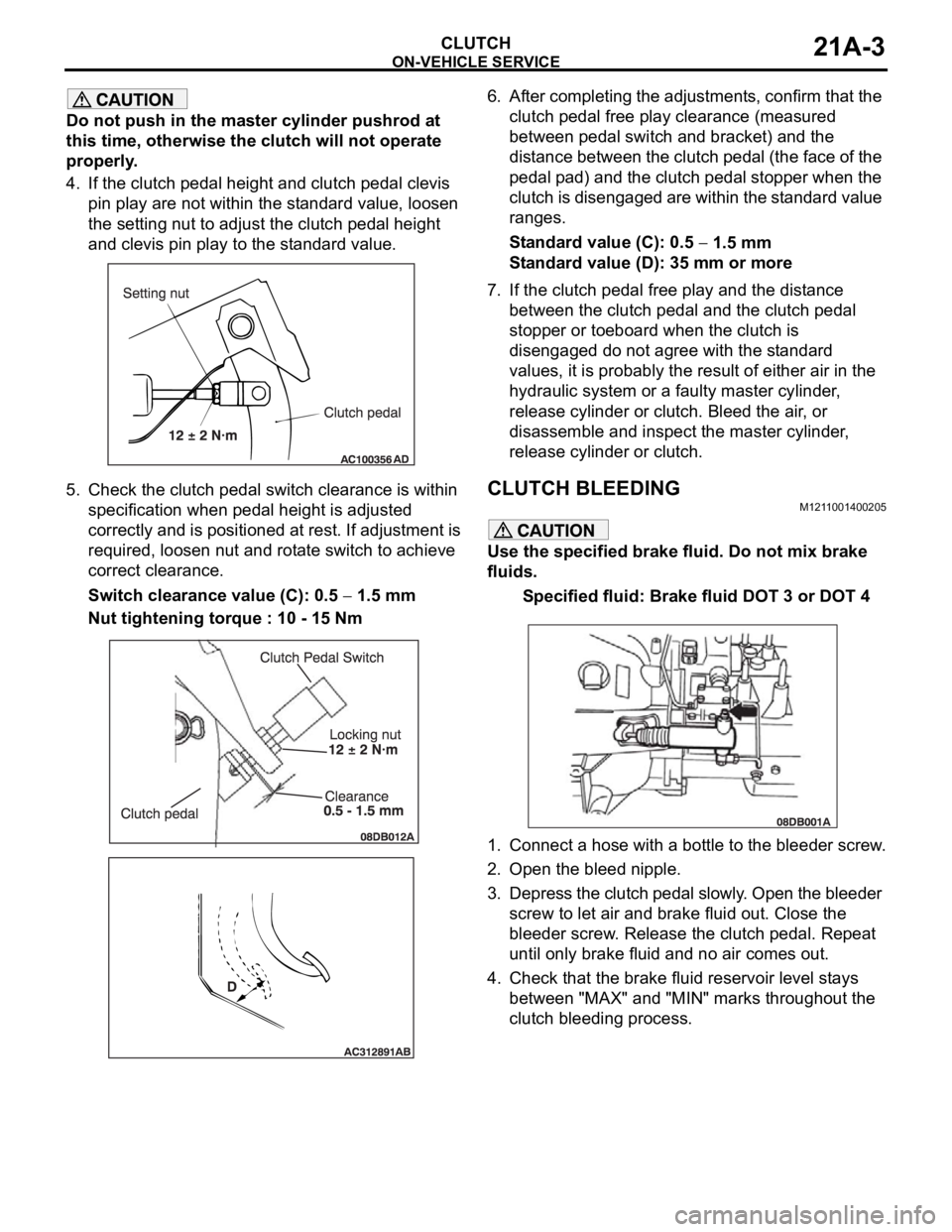
ON-VEHICLE SERVICE
CLUTCH21A-3
Do not push in the master cylinder pushrod at
this time, otherwise the clutch will not operate
properly.
4. If the clutch pedal height and clutch pedal clevis
pin play are not within the standard value, loosen
the setting nut to adjust the clutch pedal height
and clevis pin play to the standard value.
5. Check the clutch pedal switch clearance is within
specification when pedal height is adjusted
correctly and is positioned at rest. If adjustment is
required, loosen nut and rotate switch to achieve
correct clearance.
Switch clearance value (C): 0.5
1.5 mm
Nut tightening torque : 10 - 15 Nm6. After completing the adjustments, confirm that the
clutch pedal free play clearance (measured
between pedal switch and bracket) and the
distance between the clutch pedal (the face of the
pedal pad) and the clutch pedal stopper when the
clutch is disengaged are within the standard value
ranges.
Standard value (C): 0.5
1.5 mm
Standard value (D): 35 mm or more
7. If the clutch pedal free play and the distance
between the clutch pedal and the clutch pedal
stopper or toeboard when the clutch is
disengaged do not agree with the standard
values, it is probably the result of either air in the
hydraulic system or a faulty master cylinder,
release cylinder or clutch. Bleed the air, or
disassemble and inspect the master cylinder,
release cylinder or clutch.
CLUTCH BLEEDINGM1211001400205
Use the specified brake fluid. Do not mix brake
fluids.
Specified fluid: Brake fluid DOT 3 or DOT 4
1. Connect a hose with a bottle to the bleeder screw.
2. Open the bleed nipple.
3. Depress the clutch pedal slowly. Open the bleeder
screw to let air and brake fluid out. Close the
bleeder screw. Release the clutch pedal. Repeat
until only brake fluid and no air comes out.
4. Check that the brake fluid reservoir level stays
between "MAX" and "MIN" marks throughout the
clutch bleeding process.